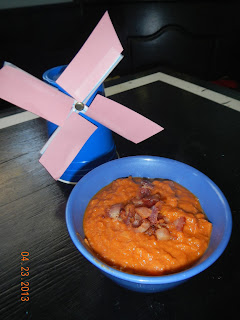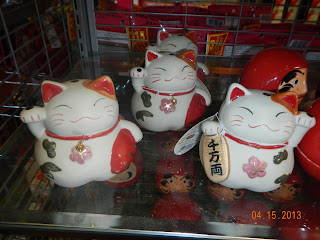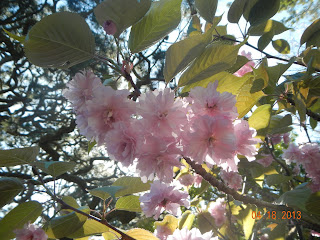Ohayou goza masu!!
That means Good Morning! I hope you all had a great weekend! We are going swimming (it's going to be in the 80's today!!) but first I've got some more work to do on Japan!! Let's learn some common words and phrases and then I have a great recipe for Teriyaki Chicken from scratch!!
Yes- hai No - iie Thank You- Arigato Goodbye - Sayonara
Happy Birthday - Tanjyoubi omedetou gozaimasu
Enjoy (your meal)- wo tanoshinde kudasai
I Love You- Daisuki Desi
1 - ichi 2- ni 3- san 4- yon 5- go 6- roku
7- nana (or shichi) 8- nachi 9- kyuu 10- jyuu
Yellow- ki iro blue- ao red- aka white- shiro
black- kuro grey- hai iro purple- murasaki green- midori
Now your treat for being so good....
Teriyaki Sauce (from scratch!)
For the recipe you will need:
(The ingredients used are pictured in the next recipe)
4 T honey (we were out of honey so I used Golden Syrup)
4 T Mirin (a sweet rice cooking wine you can fine in Asian aisle)
4 T Sake (You'd probably find this in the alcohol section)
4 T Soy sauce
 That's it! Combine them all together and use as is if you like a dipping sauce or a marinade. Or use it in this recipe I got from an interesting website called No recipes. You should check it out- it had a lot of good recipes despite the name :) Traditionally, Teriyaki is a grilled dish cooked on a hibachi (small charcoal grill) but this technique is cooked in a skillet.
It was delicious and it cooked the alcohol out of the Teriyaki sauce if you are concerned about that!!
That's it! Combine them all together and use as is if you like a dipping sauce or a marinade. Or use it in this recipe I got from an interesting website called No recipes. You should check it out- it had a lot of good recipes despite the name :) Traditionally, Teriyaki is a grilled dish cooked on a hibachi (small charcoal grill) but this technique is cooked in a skillet.
It was delicious and it cooked the alcohol out of the Teriyaki sauce if you are concerned about that!!
Chicken Teriyaki
For the recipe you will need:
1. Combine the chicken, ginger and salt and let them sit for at least 30 mins. Pat the chicken dry.
2. Heat oil in a heavy skillet set on medium heat. Put chicken in hot oil skin side down and fry until golden on one side.
3. Turn over the chicken and add the Sake (or you could use water, chicken broth, orange juice) Cover pan and let chicken steam until it is almost cooked through.
4. When the chicken is cooked most of the way drain any liquids that are in the pan. Turn your heat to high and add teriyaki sauce.
5. Let the teriyaki sauce boil and thicken and turn the chicken often so that it is all coated. The sauce will thicken into a beautiful glaze and the chicken will be a wonderful mahogany color!! Serve with rice and the any sauce left in the pan!!
I love this recipe! It always makes me feel good when I know what's in my food and this was so simple!! Yeah, it was initially a little expensive because we don't normally keep Sake and Mirin on hand, but I found a small bottle of each at the Japanese market. The sauce was RAVED about by my family and I've already had requests to make it again!! I can only imagine that it could be doctored up in many ways- maybe some pineapple or orange juice? Sesame seeds?
For dessert we had ice cream mochi. Mochi is a sweet rice flour treat. They are sticky and chewy and I really like them. Ice cream mochi is that sticky, chewy stuff with ice cream in the middle!! How can you go wrong? Ok, I'm getting hungry I need to stop!
Have a wonderful weekend people!! I'm going swimming :)
 The most Southern country in Europe and also a place more packed with historical sites than possibly anywhere else in the world. The whole of the capital city of Valletta ( 35.90°N/ 14.51°E) is considered a World Heritage Site.
The most Southern country in Europe and also a place more packed with historical sites than possibly anywhere else in the world. The whole of the capital city of Valletta ( 35.90°N/ 14.51°E) is considered a World Heritage Site.
 The location of the islands and the natural deep harbors made Malta a very prized strategic location for both the North Africans and the Greeks and Romans. In 1530, the Holy Roman Emperor, Charles V, gave control of Malta to the Order of the Knights of St. John. The knights built a renowned hospital, churches, fortresses and greatly expanded maritime trade for the islands. Their reign was considered Malta's "Golden Period". The Knights ruled the islands from 1530 until 1798, when Napoleon Bonaparte attacked and won control of the country. Luckily, many of the historical buildings and fortified villages still remain standing for tourists and visitors to see.
The location of the islands and the natural deep harbors made Malta a very prized strategic location for both the North Africans and the Greeks and Romans. In 1530, the Holy Roman Emperor, Charles V, gave control of Malta to the Order of the Knights of St. John. The knights built a renowned hospital, churches, fortresses and greatly expanded maritime trade for the islands. Their reign was considered Malta's "Golden Period". The Knights ruled the islands from 1530 until 1798, when Napoleon Bonaparte attacked and won control of the country. Luckily, many of the historical buildings and fortified villages still remain standing for tourists and visitors to see. 




























































